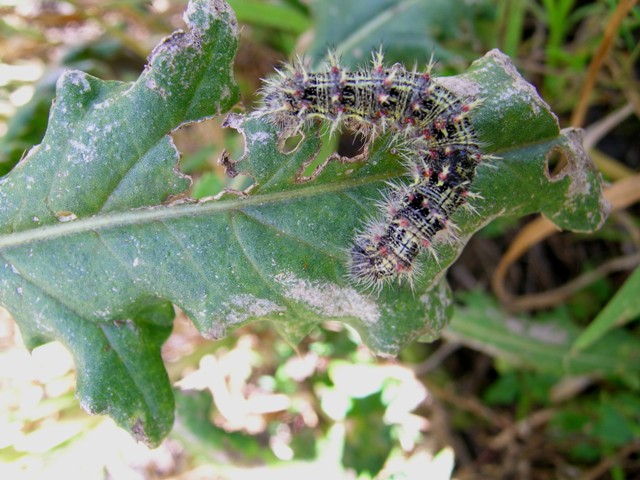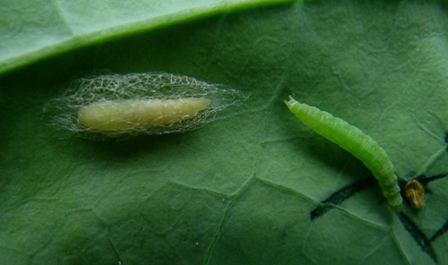Manitoba Insect & Disease Update
Issue 7: July 5, 2017
Summary
Insects:
Thistle caterpillar has been noted in some soybean and sunflower fields. Some levels of diamondback moth larvae approaching threshold have been noted in some canola fields in the southwest.
Pathogens: There have been additional reports of suspected Phytophthora root rot in soybean. Growers in the western part of Manitoba are considering whether or not to make a fungicide application for FHB and sclerotinia based on the hot and dry conditions.
Phytophthora Root Rot in Soybean
Phytophthora root rot in soybean continues to be reported across Manitoba. Most of the cases are located in the Red River Valley, but there is also a suspected case in southwestern Manitoba. At this time of year, Phytophthora root rot is not always easily distinguishable from other root rots. It is recommended for suspected samples to be sent to the Crop Diagnostic Lab for identification. When sending samples for identification it is best to include plants that are not completely senesced or necrotic. Living tissue is required in order to isolate the pathogen from the infected plants.
Fusarium Head Blight and Sclerotinia Stem Rot Risk
Spring wheat and canola in western Manitoba are at or nearing the flowering period. This is the timing in which growers are deciding whether or not to spray a fungicide for Fusarium head blight (FHB) in wheat and sclerotinia in canola.
The FHB risk maps indicate a low risk for FHB infection at this point in time in western Manitoba. These maps are based on temperatures and precipitation in the last 7 days. The ideal temperatures for Fusarium infection are between 15 and 30 degrees Celsius. Daytime temperatures this week will not likely be conducive to FHB infection, but overtime temperatures coupled with humidity or precipitation may still lead to infection.
Manitoba Agriculture does not produce risk maps for Sclerotinia in canola. Growers in southern Manitoba may access the North Dakota State University Sclerotinia risk maps if they are interested. A good rule of thumb for Sclerotinia risk is the "pant leg" test. This refers to the moisture within the crop canopy at different times of the day based on the moisture collected on your pant legs after walking through the crop. If your pant legs are dry after walking through the crop at 10 am indicates that the chance of Sclerotinia infection is low. However, if you pant legs are still collecting moisture in the early afternoon there is a much higher risk of Sclerotinia infection.
The forecast for the next week will also play a role in the fungicide decision. Hot and dry conditions are not conducive to infection or symptom development. These conditions will also accelerate the flowering process. A shorter flowering period results in a shorter period of time where the crop is at the susceptible stage.
Thistle Caterpillars
Thistle caterpillar (Vanessa cardui) feed primarily on Canada thistles, but will also occasionally feed on crops like sunflowers, soybeans, and canola. They are generally at low enough levels in these crops that they are not regarded as economic pests. Adults of these caterpillars are commonly known as painted lady butterflies.
Larvae build a nest by producing a loose webbing, which at times may result in the leaves being folded or tied together. Frass produced by the larvae may become entrapped in the nest.


Figure 1. Thistle caterpillar.
A suggested threshold in soybeans is 25 to 30% defoliation prior to bloom; 20% after bloom or pod set. Although individual plants may have some feeding, it would be very rare for a soybean field to on average have this level of defoliation from thistle caterpillar.
A suggested threshold in sunflowers is 25 per cent defoliation provided that most of the larvae are still under about 3 centimetres (1 1/4) inches) long. If the majority of larvae are fully grown, most of the feeding damage will have already occurred.
A Manitoba Agriculture factsheet on thistle caterpillars is available at: http://www.gov.mb.ca/agriculture/crops/insects/thistle-caterpillar.html
Diamondback moth
Larval populations of diamondback moth have been approaching threshold levels in some canola fields in the southwest. Generally canola can compensate well for diamondback moth feeding to buds and flowers, provided soil moisture is adequate. Some of the areas where the diamondback moth populations were high were also areas that had been drier. So in addition to the diamondback moth populations, consider the growing conditions and the plants abilities to compensate for bud and flower feeding. Heavy rainfall can be a mortality factor of eggs and early instars of diamondback moth. So in addition to providing moisture to help the plants compensate for feeding, with heavy rains larvae are very susceptible to drowning, and may be washed or wriggle to leaf axils or the ground where they drown in accumulated water. If it is decided that an insecticide application is needed, and there is any flowering on the crop, you want to make sure you minimize risk to pollinators, which can help increase the yield of canola. Products are registered in canola that have little impact on pollinators. If a more broad spectrum insecticide is being used, such as one of the pyrethroids, make sure to spray as late in the day as possible to minimize harm to pollinators. A list of hazard ratings of insecticides to bees is available on page 621 of the Guide to Field Crop Protection.

Figure 2. Diamondback moth pupa (left) and larva (right)
Insect Monitoring Programs
Bertha Armyworm: Cumulative counts from traps for bertha armyworm are currently quite low. Highest counts so far are:
Table 1. Highest cumulative trap counts for bertha armyworm adults over the trapping period June 4 to July 5, 2017.
| Location | Region | Count |
|---|---|---|
| Napinka | Southwest | 194 |
| Tilston | Southwest | 83 |
| Benito | Northwest | 81 |
| Somerset | Central | 72 |
A more detailed update of bertha armyworm counts in Manitoba is available on the Manitoba Agriculture website at: http://www.gov.mb.ca/agriculture/crops/insects/bertha-armyworm-forecast.html
----------------------------------------------------------------------------------------------------------------------
Compiled by:
John Gavloski, Entomologist Holly Derksen, Field Crop Pathologist
Manitoba Agriculture Manitoba Agriculture
Phone: (204) 750-0594 Phone: (204) 750-4248
To report observations on insects or plant pathogens that may be of interest or importance to farmers and agronomists in Manitoba, please send messages to the above contacts.
To be placed on an E-mail list so you will be notified immediately when new Manitoba Insect and Disease Updates are posted, please contact John Gavloski at the address or numbers listed above.

